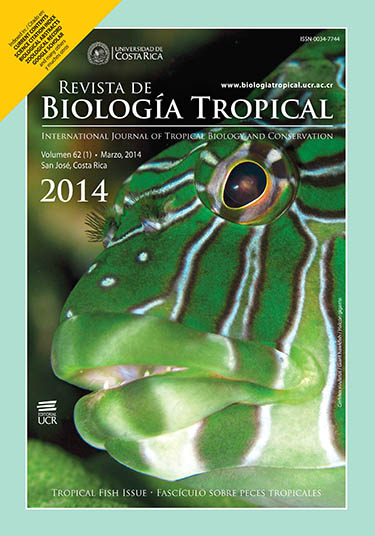Abstract
Rock fragment fields are important habitat for biodiversity maintenance in coastal regions, particularly when located in protected areas dominated by soft sediments. Researches in this habitat have received surprisingly little attention on the Amazon Coast, despite rock fragments provide refuges, nursery grounds and food sources for a variety of benthic species. The present survey describes the mobile macroinvertebrate species composition and richness of the intertidal rocky fragments in Areuá Island within the “Mãe Grande de Curuçá” Marine Extractive Reserve (RESEX) on the Brazilian Amazon Coast. Samples were collected during the dry (August and November 2009) and rainy seasons (March and May 2010) on the upper and lower intertidal zone, using a 625cm² quadrat. At each season and intertidal zone, macroinvertebrate samples were collected along four transects (20m each) parallel to the waterline, and within each transect two quadrats were randomly sampled. Macroinvertebrates were identified, density determined, and biomass values obtained to characterize benthic diversity from the rocky fragments. The Jackknife procedure was used to estimate species richness from different intertidal zones during the dry and rainy seasons. Macrofaunal community comprised 85 taxa, with 17 “unique” taxa, 40 taxa were common to both intertidal zones and seasons, and 25 taxa have been recorded for the first time on the Brazilian Amazon Coast. Species richness was estimated at 106±9.7 taxa and results suggest that sampling effort was representative. Polychaeta was the most dominant in species number, followed by Malacostraca and Gastropoda. Regarding frequency of occurrence, Crustacean species Dynamenella tropica, Parhyale sp. and Petrolisthes armatus were the most frequent representing >75% of frequency of occurrence and 39 taxa were least frequent representing <5% of frequency of occurrence. Occurrence of crustaceans and polychaetes were particularly noteworthy in all intertidal zones and seasons, represented by 15 and 13 taxa, respectively. The most representative class in abundance and biomass was Malacostraca that represented more than half of all individuals sampled, and was dominated by Petrolisthes armatus. The latter was one of the most frequent, numerous and higher biomass species in the samples. In general, results indicated greater richness and biomass in the lower zone. Additionally, richness and density increase during the rainy season. Rock fragment fields in Areuá Island are rich in microhabitats and include a diverse array of species in a limited area. Our results underline the importance of rock fragment fields in Areuá Island for the maintenance of biodiversity in the Amazon Coast.Comments
Downloads
Download data is not yet available.






